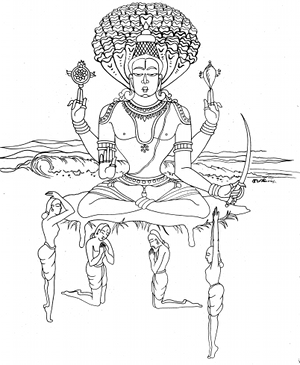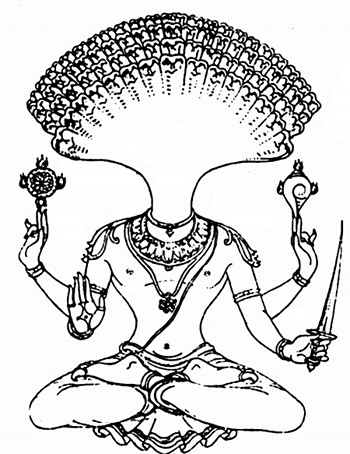Letting Go
Patanjali’s Yoga Sutra-s (YS) I-12
 Abhyāsa-vairāgyābhyām-tannirodhaḥ That centred, grounded state (tannirodhaḥ) can be reached both by letting in something new (abhyāsa) and by letting go of something old (vairāgyābhyām).
Abhyāsa-vairāgyābhyām-tannirodhaḥ That centred, grounded state (tannirodhaḥ) can be reached both by letting in something new (abhyāsa) and by letting go of something old (vairāgyābhyām).
Letting Go – Vairāgyābhyām Letting go of something or someone we are attached to is one of the hardest human endeavours. The power of attachment, which we often call love, can blind and bind us, creating much suffering for ourselves and others.
Vairāgyābhyām means to cut away (vai-) any desires or attachments (-rāgyābhyām) that are not allowing us to practice being present (abhyāsa) and fully experience that centred, grounded state of Being (tannirodhaḥ), the precursor to experiencing Yoga (YS I-2).
Attachments in themselves are not the problem The Yogic tradition uses attachments and relationships as practice tools (abhyāsa) for healing and transformation. Whatever we link to, we become like for better or worse. It all depends on whether the attachment centers or distracts us from bonding with our authentic Selves.
For example, nourishing relationships (sat-sanga) with friends, family, and Spirit can provide us with much strength and Joy. They can also be the source of much transformation since we often attract friends into our lives with qualities we admire and hope to own within ourselves.
In traditional Yogic meditation practices, we likewise link with objects that have qualities we hope to mirror. For instance, TKV Desikachar in 2002 asked me to pick a mountain to meditate upon to create more stability and groundedness in the face of life’s many changes and challenges. I picked holy Mt. Kailash and to this day, this is one of my main objects of meditation. As a result, over time, I have become more grounded, less shakable, and more committed to whatever direction I have chosen. Another example is the Sun. I meditate on the Sun daily to remind myself of the light (jyoti) shining in my heart (YS I-36). Patanjali says by meditating on the Light in our hearts, our minds become light and clear. We become like that object to which we attach.
So when is it important to let go or detach from our attachments? When an attachment takes you off course or makes you ungrounded and uncentered, you know it is getting in the way of you experiencing tannirodhaḥ (grounded, centered mind-body). You know it is time to let it go because it is keeping you from being able to practice being present (abhyāsa). It is keeping you from living the life that you are being called to live in this moment. It is keeping you from following your Bliss!
Think about your daily Yoga practice (sādhana/ abhyāsa) What keeps you from getting to your Yoga practice or other commitments of self-care? For me, it is email, Facebook and Twitter first thing in the morning. I have to use discipline (tapas,YS II-32) to cut this impulse because it is interfering with my daily self-care.
Think about your relationships After four months of us trying to let go of a deeply attached relationship, we are both finally ready to make the final cut (vairāgyābhyām). We have both realized that the relationship in its present form has been throwing us off course. We need to let it go to get centred and real with what is true in this moment.
Letting in and Letting go are a process. They do not happen overnight just because we decide to do so. It takes time to develop new healing habits and relationships so that we can let go of old ones no longer serving us.
Next month, we will discuss how to stay grounded/centered (tannirodhaḥ) (YS I, 13-16) and what that transformative process looks like over time (YS I, 17-18).
Yoga Sutra Question What do I need to let go of right now so that I can get more centred and grounded in my Truth, my Heart?

 Sundays, Maggie Reagh presents a series of blog posts on one of Patanjali’s key Yoga Sūtra-s (YS), encouraging you to reflect on how it relates to your current life situation through a Yoga Sūtra Journal Question.
Sundays, Maggie Reagh presents a series of blog posts on one of Patanjali’s key Yoga Sūtra-s (YS), encouraging you to reflect on how it relates to your current life situation through a Yoga Sūtra Journal Question.
 I-1 Atha-yogānuśāsanam Now, let’s start our study of Yoga as it has been practiced, experienced, applied, and only then passed down from teacher to student throughout the centuries. May it be an auspicious beginning for the benefit of all future generations of Yogi-s.
I-1 Atha-yogānuśāsanam Now, let’s start our study of Yoga as it has been practiced, experienced, applied, and only then passed down from teacher to student throughout the centuries. May it be an auspicious beginning for the benefit of all future generations of Yogi-s.